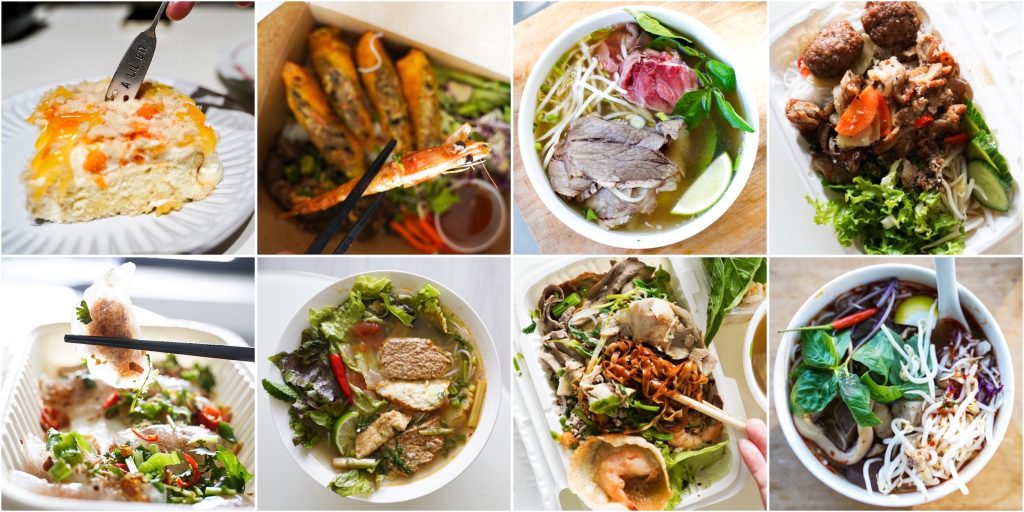
What are famous Hanoi foods? is one of the questions we get asked the most by visitors.
The first is self-evident; everyone is aware that Hanoi offers the best Pho bo (beef noodle soup). And depending on who you ask, the foods that we would consider to be iconic in Hanoi can vary greatly. Is grilled pork noodle soup, bun cha, a Hanoi specialty? How about coffee with eggs? A Banh Mi would be a baguette with pate. Or how about different types of soups like Bun ngan (Muscovy noodle soup), Bun rieu (crab noodle soup), and others?
We came up with a list of the top 10 meals to eat in Hanoi after sitting down for coffee and thinking about it. Some are well-known because they originated in Hanoi, while others were developed in other Vietnamese provinces but gained popularity there since Hanoi has served as the nation’s capital for more than a thousand years. Certain dishes from other cultures, such as Chinese and French, were adapted since they were brought here and heavily incorporated into our regional diet.
1. Pho bo (beef noodle soup)
There are two varieties of pho, and either beef or chicken is offered. Vietnamese for “beef noodle soup” is “pho bo,” and it is regarded as a national dish in that country. Nam Dinh, a province south of Hanoi with a large farming population, is credited with creating pho bo. The flavor of Pho bo was elevated when it was introduced to Hanoi in the early 20th century by Hanoian eateries.
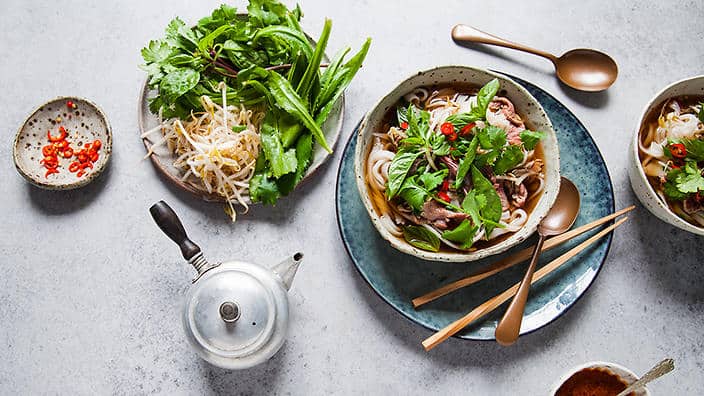
The majority of Vietnamese people and pho experts agree that Hanoi is the only city where pho is served, not just because it has the best flavor. Eating Pho bo has thus become a must-try for travelers to Hanoi and is advised for both Vietnamese from other cities and foreigners.
A typical bowl of Pho bo is made of rice noodles, marrow-rich beef stock, thinly sliced beef, minced ginger, and fresh spring onions. Various families in Hanoi have a secret recipe for their distinct flavor.
We frequently eat Pho bo for breakfast on our way to work, like the majority of Hanoians. As a result, Hanoi’s Pho used to be known as the city’s most popular breakfast. Well, it still is. But, people increasingly consume Pho bo for breakfast, lunch, and dinner.
So be sure to taste Pho bo if you find yourself in Hanoi! Make sure you add a teaspoon of rice vinegar (or a lime slice) and a drop of the chili paste that is available on the table when you do, no matter where you obtain it from. You won’t be sorry!
2. Bun cha (noodle grilled pork)
Hanoi has a reputation for cooking rice noodles, well, with virtually everything, thanks to the popularity of the beef noodle soup. We Vietnamese may be genetically predisposed to it because Vietnam just received five world records from the World Records Union for possessing the most “strand and broth” meals (164 dishes).
You might be curious as to whether Pho and Bun use the same type of noodle. Although they have slightly distinct shapes, they are both composed of rice. Whereas Bun noodles are cylindrical like spaghetti, Pho noodles are flat and thick like fettuccine.
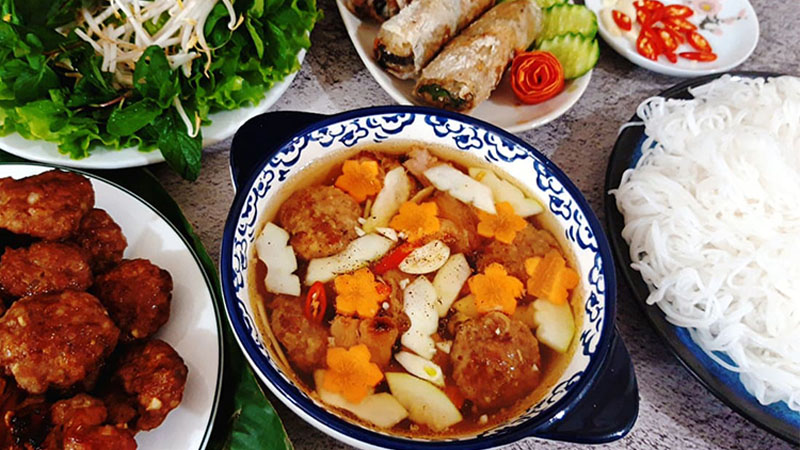
In a soupy bowl of fish sauce that has been thinned out, meatballs, pickled kohlrabi, and carrot are added to charcoal-grilled, fatty pork. Together with it are fresh herbs including perilla, coriander, and lettuce as well as a side of rice noodles (bun).
If Pho bo is the most well-liked morning food in Hanoi, then Bun cha must be the most well-liked lunch dish there. We frequently advise visitors who adore the meal that whenever they see smoke on the street, Bun cha is nearby. On the sidewalk, folks are roasting pork over fire. Naturally, not all of their neighbors are pleased with the smoke billowing in front of their businesses.
3. Bun thang (Like-Herbal-Medicine Noodle Soup)
Got to explain what does Bun thang mean first. While thang is derived from Thang Thuoc in Vietnamese, which indicates a unit of traditional Chinese herbal medicine, bun is translated as rice vermicelli (like the noodle in Bun cha above). Hanoian people call the soup Bun thang because it has a small amount of up to 20 components arranged in various proportions of herbal remedies on top.

In order to make bun thang, rice vermicelli noodles are cooked in a chicken or occasionally a pork broth and then topped with salted dried shrimp floss, finely chopped chicken, ham slices from Vietnam, scrambled eggs, and shiitake mushrooms. Afterwards, green onions, Vietnamese coriander, fried shallots, and a few slices of red chili pepper are added as garnishes to the noodle soup. The finished Bun thang dish has a clear broth, a striking appearance, and a pleasant aroma.
Bun thang has a mild flavor in comparison to other Vietnamese noodle dishes. To enhance the flavors, the dish is therefore served with toppings such lime, rice vinegar, shrimp paste, and chili sauce. Like shrimp paste, which has a very pungent fragrance, but when added to the soup, the pungent flavor is completely lost and the broth takes on a pleasant earthy scent instead!
4. Bun ngan (Muscovy duck noodle soup)
This might be intriguing, though. In Hanoi, Pho is regarded as the most popular morning food, Bun cha is the most popular lunch dish, and Bun ngan is the most well-liked street food for supper.
Signs of Bun ngan begin to appear on numerous Hanoi streets around midday and continue there till midnight. We can always locate a Bun ngan still open even after the majority of other street food vendors have closed their doors for the day.
Bun ngan is a tasty dish that combines boiling Muscovy duck with bamboo shoots, rice vermicelli noodles, and spring onions on top. Cellophane noodles are used in place of rice noodles in the soup known as Mien Ngan.
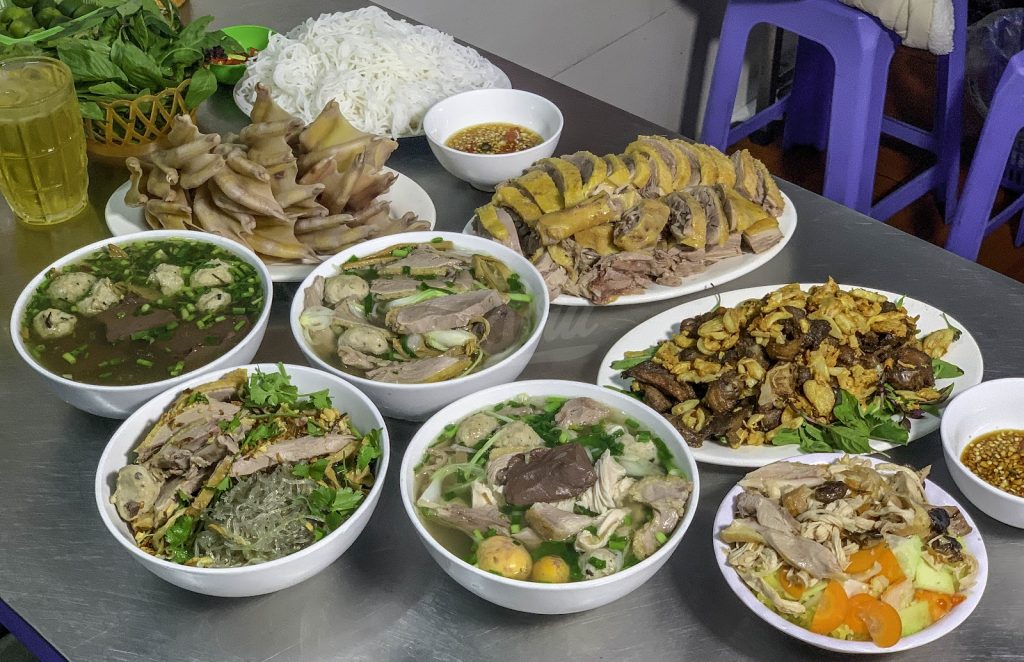
When visiting Hanoi, be sure to have this meal since it is rarely found elsewhere. The Old Quarter of Hanoi is the perfect area to seek for one because there, the locals boiled tons of Muscovy ducks to make a delicious broth for dinner!
We’re going to change our focus and move on to other food categories that may be regarded as Hanoi’s famed cuisine rather than continuing this pattern of “[food] noodle soup”!
5. Banh Mi (Vietnamese baguette with pate)
Because of the significant French immigration to Hanoi during the colonial era, French food has inevitably become a staple of the city’s residents’ daily diets. The banh mi stands out as a favorite among the French contributions.
Even though the French introduced the baguette to Vietnam, the Vietnamese elevated it. The core ingredients of Hanoi baguettes—a cornucopia of roasted chicken or pig, homemade swine liver pâté, headcheese, carrot, a liberal sprinkle of cilantro leaves, slices of cucumber, and chili sauce—remain the same across the length of the country, with some regional variations. Combining those flavors—spicy, salty, sour, savory, and aromatic—make biting into a properly built Hanoi baguette an exhilarating experience!
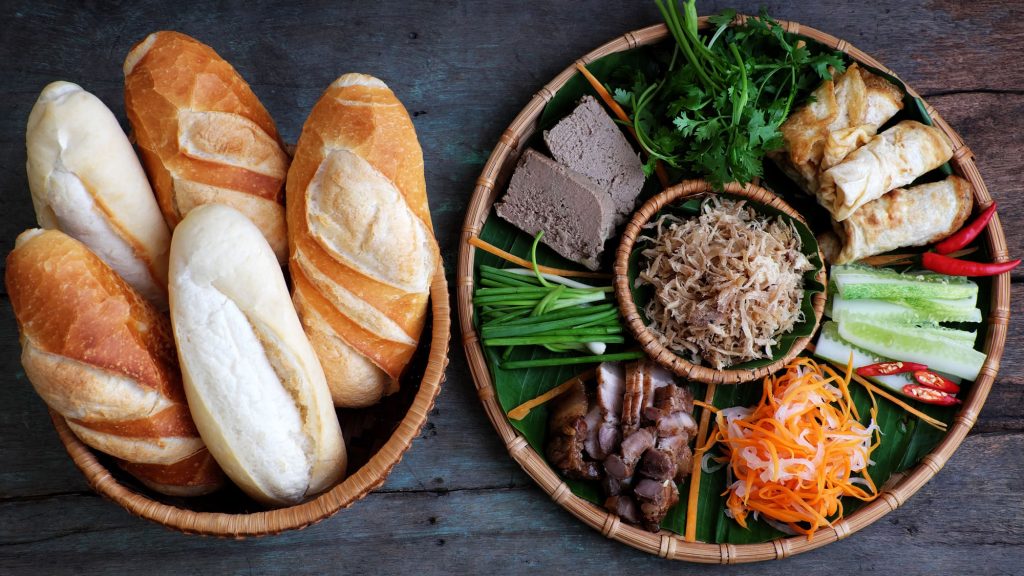
In Hanoi, customers can get this baguette in upscale hotels, eateries, cafés, and food carts all across the city. It offers straightforward and delectable breakfast and lunch fare. Long before Hanoi street food became a gastronomic preoccupation for foodies, particularly international tourists, it was a street meal that locals hardly thought about. So, eating a banh mi is essential when exploring the city’s restaurants.
6. Cha Ca (grilled turmeric-marinated catfish)
There is no dish more representative of Hanoian cuisine than Cha ca, a grilled catfish marinated in turmeric and served with rice noodles and fresh dill. During the time of French colonial control, the Doan family began serving Vietnamese patriots this dish of grilled catfish over 130 years ago. Because of how amazing their cha ca was, the street where the restaurant is located was given the moniker Cha Ca Street.
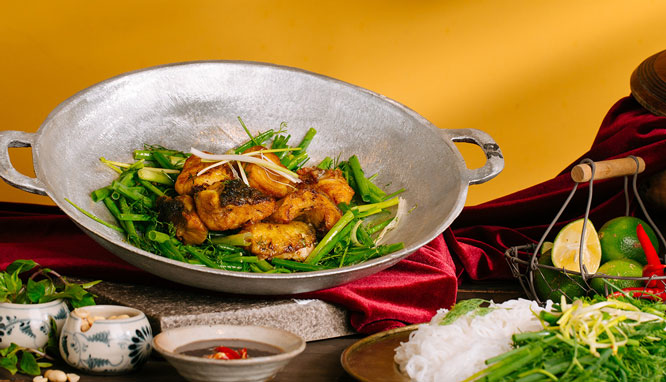
Cha ca is a cuisine we need to go to some specific family-run restaurants, including the original one – Cha Ca La Vong at 14 Cha Ca Street, or Cha Ca Thang Long at 21 Duong Thanh Street, as opposed to most other Vietnamese foods in Hanoi being offered on many different streets.
Catfish (or snake head fish) that has been marinated in turmeric and is being fried at the table in a skillet with lots of spring onions and fresh dills is the main ingredient in the dish. It comes with roasted peanuts, white rice vermicelli noodles, and other fresh herbs.
Hence, Cha ca is the dish to try if you want to sample a well-known Hanoi dish that was entirely produced there.
7. Banh com (young sticky rice cake)
Vietnamese cities generally have a signature dessert, and Hanoi’s is Banh com, a cake consisting of young rice and mung beans. This traditional young rice cake, another well-known specialty of Vietnam, is frequently a requirement for marriage proposals in the country’s northern regions. Green beans, grated coconut, and lotus jam are used as fillings in this cake, which is produced from the most fragrant young sticky rice grains.
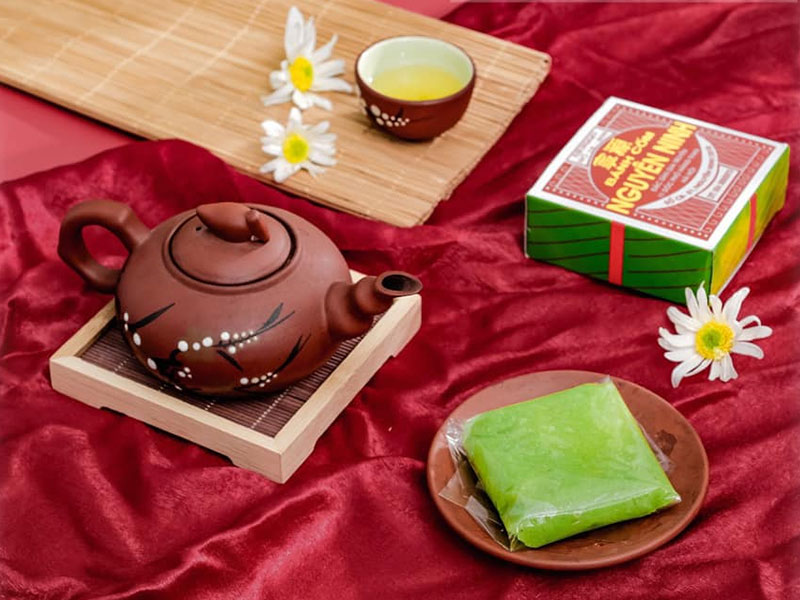
Therefore if you’re interested in sticky rice, Banh com Hanoi is a must. Although you can buy them in most places, for the whole experience head to Hang Than street, where there are approximately a hundred Banh com stores. One of the first families to make banh com on the street, Banh com Nguyen Ninh is located at 11 Hang Than Street and is one of our favorite restaurants.
When we go to the country, we frequently buy banh com to bring home and share with our ants and neighbors since they enjoy drinking tea with sweet cakes. Banh com tastes particularly good when consumed with a cup of Vietnamese tea.
8. Banh cuon (rice noodle rolls)
There are a lot of dishes striving to be a Hanoi landmark in the realm of breakfast meals. Together with the Pho you are already familiar with, Banh cuon is another meal that is unquestionably exceptional.
A thin, wide sheet of fermented rice batter is steamed to create this rice noodle roll. The rice sheet, which is produced by delicately steaming rice batter over a cloth stretched over a kettle of boiling water, is incredibly delicate.
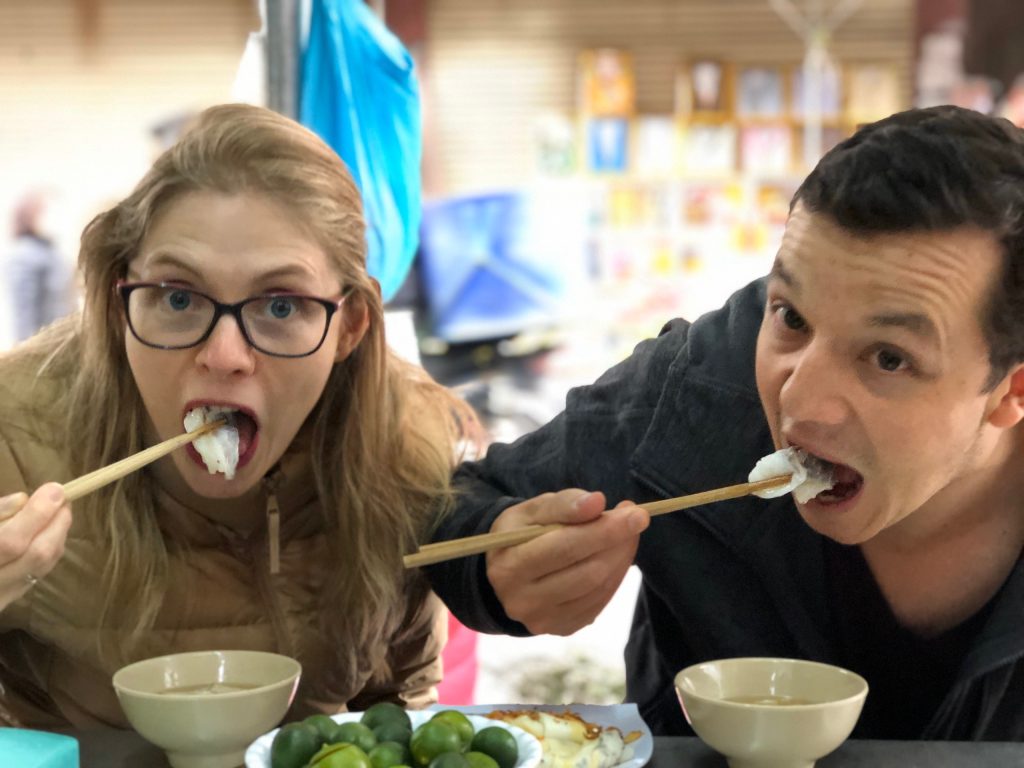
Each noodle roll is stuffed with a combination of ground pork that has been roasted and spiced, wood ear mushrooms, and shallots. Finally, some fried shallots and fresh cilantro or mint are sprinkled on top of the dish. This dish frequently includes a bit of Cha lua, a Vietnamese pork sausage, and dipping sauce spiced with a dash of ca cuong (giant water bug).
9. Caphe trung (egg coffee)
We humbly request that you are familiar with Vietnamese coffee, which is robust and delicious when served with sweetened condensed milk. With the dedication of the Vietnamese growers to their farms, Vietnam is now the second-largest producer of coffee in the world, and many of us are grateful to the French for bringing the coffee tree to the country.
Yet, what we’re really talking about here is egg coffee, which was created by Hanoians during the resistance battle, not simply your typical Vietnamese coffee. Mr. Giang made the egg coffee for his own coffee shop by mixing the egg yolk and sweetened condensed milk. We believe he was unaware that his coffee would become a Hanoi must-try and that his family’s coffee business would grow to be one of the busiest in the city.
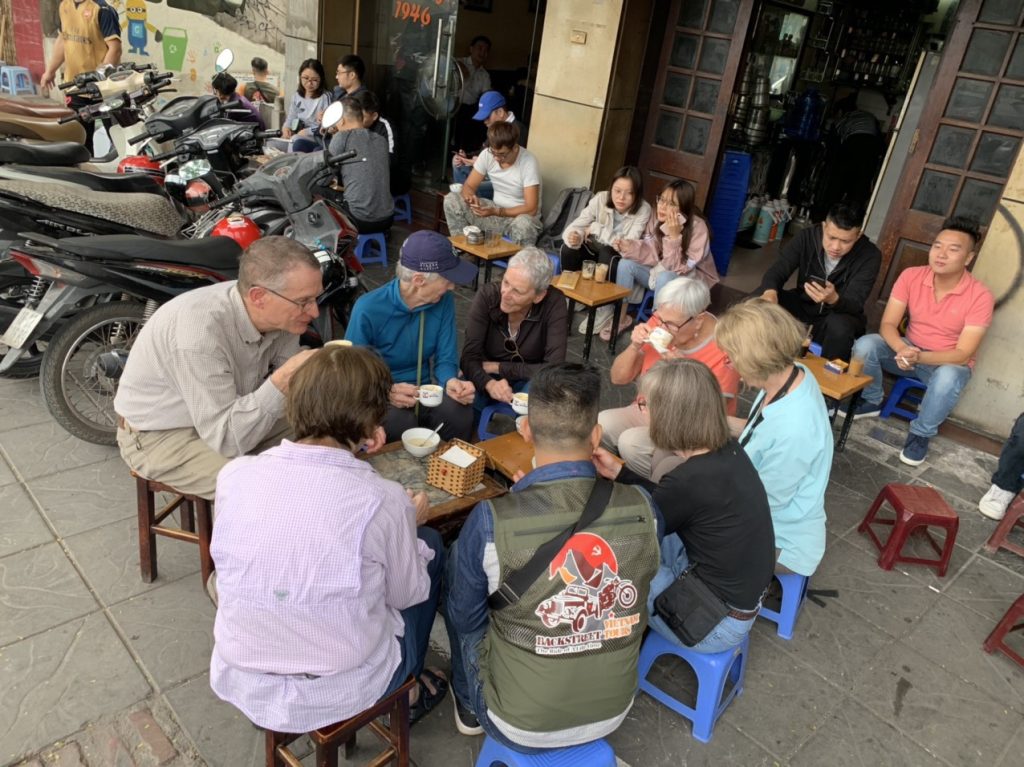
Even though many of our passengers came to the conclusion that it tastes like liquid tiramisu, you can tell after just one sip of the original Hanoi egg coffee that it tastes slightly different.
Trying to find some?
The first family-run coffee business, Café Giang, has been operating since 1946 and is located at 39 Nguyen Huu Huan Street. Along with the egg coffee their father invented, they also sell egg matcha, egg beer, and egg ice cream. Yes, you don’t have to be a coffee drinker to attend this well-known neighborhood spot!
10. Kem Trang Tien (Trang Tien Ice Cream)
When I asked my uncle, who now lives in the city, how the city is, he always said, “Hanoi has a lot of Trang Tien ice cream!” because he grew up in the country. It was my first time ever having ice cream, and when he took me to the city, that’s what we did first.
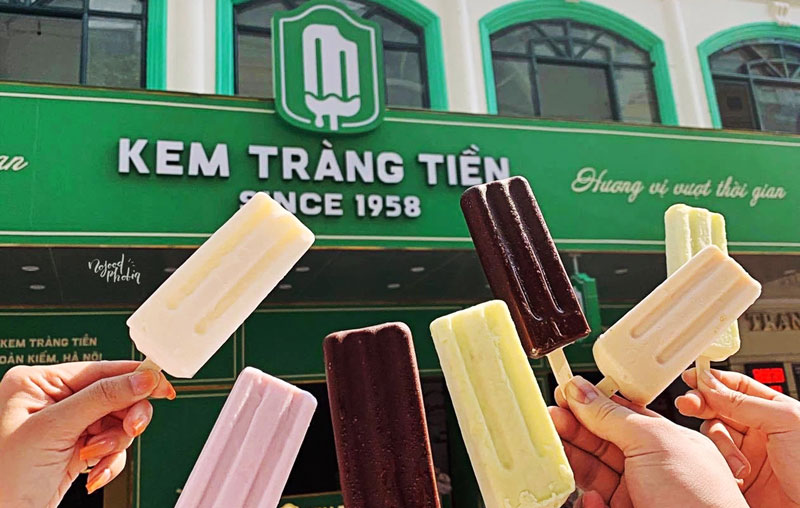
Founded in 1958 and situated just in front of the Hanoi Opera House, Trang Tien Ice Cream is actually a state-owned ice cream warehouse. This is one of the busiest locations in the city in the evenings and on weekends since Vietnamese people enjoy ice cream.
Ice cream bars or cones can be ordered, and they will be delivered to you from the freezers in the warehouse. You can select from a variety of flavors, including vanilla, young rice flavour, chocolate, and coconut. Each kind has an excellent balance of its flavor, the appropriate amount of sweetness, and a hint of icyness.




